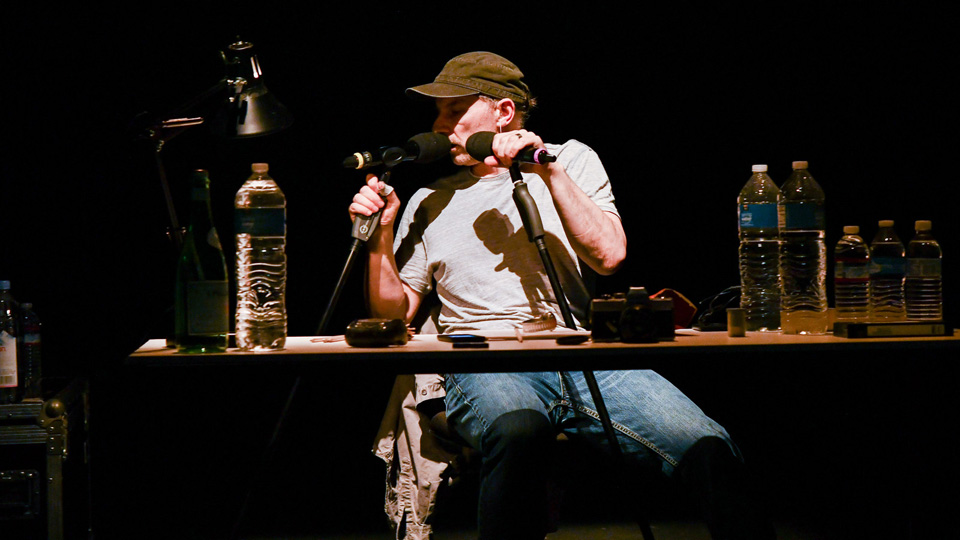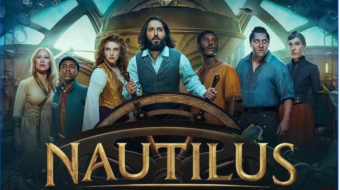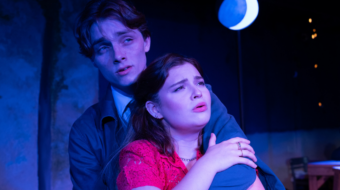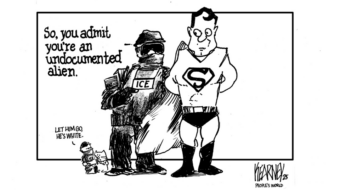
BEVERLY HILLS, Calif.—The Bram Goldsmith Theater at the Wallis Annenberg Center for the Performing Arts has been transformed into the remote Amazonian jungle inhabited by the elusive Mayoruna, known as “The Cat People.” Well, at least aurally if not visually.
The star of this one-man show is well known British actor Simon McBurney. He’s the sole actor on stage and serves as his own director. There is, of course, a small army of techies from the London-based Complicite company who make this all-encompassing aural and stage phenomenon worth experiencing.
The Encounter tells a true-ish story of the American National Geographic photographer Loren McIntyre, who made a life-changing contact with an indigenous community in northwest Brazil in 1969. As McIntyre’s well told tale mounts in suspense, McBurney confronts his audience with some profound questions about life today: What do we value, what is the nature of time, and what do we believe to be true. The theatrical adaptation is inspired by the novel Amazon Beaming by Petru Popescu.
Which reminds me of the old Yiddish actor from London’s East End who spots an ad looking for someone to play Hamlet. He phones for an audition, trudges up two flights of stairs, and meets the director. When the director hears his distinctly Jewish accent, he says, “My dear man, this is Shakespeare. You have to have the training, the experience, the voice, a familiarity with the style of acting, to be cast in this classic role.”
“Vot chu towking?” says the Yiddish actor. “I ken do anyting you vant.”
Frustrated by this pretender’s obvious inappropriateness for Hamlet, the director hands him a sheet of paper and asks for a reading. The actor begins, assuming his plummiest, most aristocratic tones:
To bee, aw nawt to bee, thaht is the question:
Whethah ’tis noblah in the mind to suffah
The slings and ahrows of outrrageous fawtyune,
Aw to take ahms against a sea of trroubles….
Shocked and taken completely aback at this magisterial command of Shakespearean language, the casting director asks, “Migod, good fellow, where did that come from?” The old Yiddish thespian points a finger sharply into the air and replies,
“Det’s vot you coll ecting!”
In The Encounter we meet some of the same issues: Who tells the story, how authentic is it, through what cultural lenses are the performer seeing it and the audience hearing it, what common language do we understand, what meanings do we bring to it, and do we take from the hearing? In fact, let’s return to Shakespeare for a minute, and let me ask: Has anyone ever staged Hamlet with Danish actors or accents (outside of Denmark, that is) to be true to its setting?
Now McBurney is completely upfront about these issues. He begins with a longish inquiry into what is fake and what is real, the mistakes we often make distinguishing fact from truth. He is highly aware that a two-hour theatrical representation of an extraordinary mystical cultural conjunction is hardly a “truthful” rendition of the original experience—mediated by the conventions of 21st-century theatergoing, a full array of lights and projections, prerecorded interviews and music, the microphones with all their sound-bending wizardry that amplifies, distorts, distends and dissimulates, and the earphones the audience members have to wear throughout the performance to get the full aural effect.
How “real” can it be when you consider that Loren McIntyre lived this episode knowing English, Spanish and Portuguese among the Mayoruna who knew no other language but their own, until eventually a member of the tribe appeared who knew Portuguese from his years spent with missionaries; that it was Petru Popescu, a Romanian writer who grew up under Communist Party leader Nicolae Ceaușescu, who interviewed McIntyre for a novel; that Popescu writes in the English of his adopted country, the U.S.; and that the British McBurney is offering this material back to an American audience?
There are definitely concerns about appropriation of indigenous culture for Western minds, and the authority of representation for this material. Besides which, what was the role of the National Geographic magazine in the first place? People of my generation remember it as a publication where black and brown breasts were bared for vicarious consumption by young boys who found in its pages the closest simulacrum of porn they could legally get their hands on.
Today, of course, the magazine is owned by media mogul Rupert Murdoch, who immediately proceeded to fire most of the journalists and photographers who built its reputation.
McBurney makes clear that The Encounter is pure storytelling, without pretense of anthropological authority. His late-night work on the script is constantly interrupted by his young child who won’t go back to sleep until he tells yet another story. Everyone is his audience. And by the way, his wife was at that moment on a Buddhist retreat, yet another sign of the capacity for Western culture to appropriate other traditions and adapt them to its own purposes.
Forty minutes into the show at the Sunday matinee, alarms went off, and ushers required the entire audience to exit the theatre. Many of us, inconvenienced by having unexpectedly to gather all our things, nevertheless believed it might be part of the show. We stood outside the perimeter of the theatre property while a Beverly Hills firetruck disgorged four firefighters to check it out. Were they part of the act? Another test of the reality/fiction binary?
After 25 minutes we returned to our seats, put our headphones back on, and the show resumed. All was well in Mayoruna land.
The Encounter reminded me of Joseph Conrad’s Heart of Darkness—a novel written in English about the Belgian Congo by another Eastern European writer. Like any gripping narrative of adventure, the thrill is in the telling. We take an epic journey—in our seats and with the aural virtual reality coming through the headphones—comprising getting lost in the jungle, tropical rainstorms and raging rivers, strange tribal customs, the disorientation of a clockless existence, intoxicating drugs and fevered dreams, wild animals and dangerous thorny plants, maggots and an ever-present presentiment of disease and death.
Your senses are mightily engaged, yet it is all very gestural. With the actor’s constant real-time asides and interruptions from his child, we are never left for long in the illusion of the story. Indeed, look up above you and you see monitors prompting Mr. McBurney on his word-for-word script. Primarily we are meant to be stunned by the actor’s hyperactivity in body and voice. Those monitors aside, no one seeing him would deny it’s a tour de force for the solo performer. There’s a whole lot of “ecting” going on. Not counting our 25-minute forced intermission, even at two hours I began feeling after about an hour and a half that he had pretty much exhausted his repertoire and I was ready for him to wind up. The prodigious audio contribution held my attention but it could not cover the eventual sense of tedium with the script.
After his standing ovation, McBurney addressed us to say that before committing himself to doing this play, he visited the Mayoruna in their Amazonian home and learned that though far from civilization, they are connected with other indigenous peoples in the worldwide movement to defend their autonomy and lives. As if, after two hours of this space-time-mind continuum we might not be 100 percent convinced, he assured us that yes, the Mayoruna people do certainly exist.
Further information about the play and tickets can be found here or by calling (310) 746-4000.
The Encounter plays at the Wallis Annenberg Center for the Performing Arts, 9390 N. Santa Monica Blvd., Beverly Hills CA 90210. Remaining performances are April 11, 12, 13, 14 and 15 at 8 pm, and April 15 and 16 at 2 pm.










